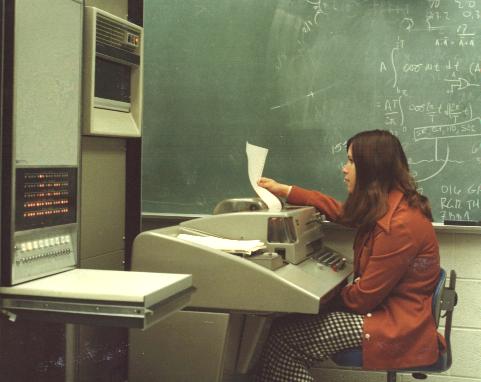





1966 HP's Text The HP2116A/B/C Computer HP's first computer, the HP 2116A was developed as a controller for HP's programmable instruments. It was the largest single mechanical package HP had ever built to date, and it marked HP's first use of integrated circuits. When HP first entered the field, most computers on the market had to be pampered in air-conditioned rooms on spring-loaded floors. HP assumed that the 2116A, an instrumentation computer, should pass the same environmental tests as the instruments it would team with. So HP quickly took the lead in ruggedness and reliability, and helped transform the computer into a go-anywhere, do-anything tool.  AICS Research's Text
The Bug Counter
The obvious similarities of HP's photograph and the one above was the impetus
that prompted me to put together this short series of web pages. The picture
above was taken in my office at New Mexico State University.
In 1968, after completing four years of satellite tracking and a change of
departments, we purchased an HP2116C to build an automated
insect indentification and classification system. The "bug counter"
eventually came to be capable of indentifying approximately four thousand insects
an hour using pattern recognition techniques.
We wrote the disc operating system for the HP2116 from scratch. Indeed,
all initial programs had to be entered through the switch register.
Although a FORTRAN compiler/operating system was available for the
HP2116, we couldn't use it. Speed and memory constraints (8K of core
RAM initially) were such for the insect counter that we found that we
had to write every routine and driver by hand to be as small and as efficient
as possible.
The bug counter's accuracy against soft-bodied insects (hemipterans,
homopterans, etc.) evolved to be generally 70 to 85%. But, on hard-bodied
insects, such as coleopterans, its accuracy climbed reliably
to between 90 and 95% correct.
The purpose in assembling the bug counter was to as quickly count and indentify
as many species of insects as possible to determine the likelihood of an
onset of infestation of several primary pest insects in cotton (cotton
bollworm and pink bollworm, principally). If these
outbreaks could be seen sufficiently far enough in advance, then parasitoid and
predator insects could be released with sufficient efficacy that
the massive use of insectides could be forestalled or eliminated altogether.
The concept underlying the construction of the insect counter is termed
Integrated Pest Management,
a very real attempt to wean farming from the
intense use of insecticides.
About thirty "scouts" (generally undergraduate and graduate students) would
regularly sweep cotton fields throughout the area.
The insects they collected would be brought
back to the lab, separated from the plant trash, and placed onto a large
scanning table to the left of the HP2116 (not visible in this photograph).
The operating system we constructed by hand
was composed of three layers, all operating simultaneously. The first tier
was wholly foreground and driven off of the interrupts generated by the
scanning table. As the table moved, an HP A/D converter was
electrically commanded by the table to
absorb readings in three visual channels (red, green and blue) from a series
of photomultipliers that we had constructed. Because there was no memory
buffering available to us, the HP2116 was, by necessity, commanded to
immediately write
this data to the 10MB Iomega disc drive (seen to the right of the computer).
The second tier of processing, simultaneous with the table's motion,
monitored the completion of an insect's
image on the disc. Once done, the software parsed the insect from the
accumulating field of data and handed it off to the third (and most background)
layer of processing, the pattern recognition algorithms, where once
identified, was added to the accruing counts of insects seen.
We knew from the beginning that the pattern recognition routines would be
least stable part of the software. Two groups from the Electrical & Computer
Engineering Department at New Mexico State
created learning algorithms to constantly better
improve their respective recognition accuracies. One team emphasized a form
of pattern recognition associated with cluster analyses and the identification
of their centroids in a multidimensional hyperspace. The second team used
what would now be known as an artificial neural net (then known as a connection
of threshold logic units). The third, and most successful,
approach proved to be to let the cotton scouts
(the students, who were for the most part, wildlife and biology students)
look at the images printed out on the TTY and let them describe
patterns that they found to be most valuable in manually identifying and
segregating the various insects.
These student suggestions were then programmed
up as a series of simple linear discriminant functions in an IF-THEN-DO format.
It was deflating to everyone's ego that the student-generated discriminant
functions always outperformed the elaborate learning algorithms that were
variously generated by the professorial teams, but that has been a surprisingly
common lesson in the history of artificial intelligence research to date.
AICS Research's Text
The Bug Counter
The obvious similarities of HP's photograph and the one above was the impetus
that prompted me to put together this short series of web pages. The picture
above was taken in my office at New Mexico State University.
In 1968, after completing four years of satellite tracking and a change of
departments, we purchased an HP2116C to build an automated
insect indentification and classification system. The "bug counter"
eventually came to be capable of indentifying approximately four thousand insects
an hour using pattern recognition techniques.
We wrote the disc operating system for the HP2116 from scratch. Indeed,
all initial programs had to be entered through the switch register.
Although a FORTRAN compiler/operating system was available for the
HP2116, we couldn't use it. Speed and memory constraints (8K of core
RAM initially) were such for the insect counter that we found that we
had to write every routine and driver by hand to be as small and as efficient
as possible.
The bug counter's accuracy against soft-bodied insects (hemipterans,
homopterans, etc.) evolved to be generally 70 to 85%. But, on hard-bodied
insects, such as coleopterans, its accuracy climbed reliably
to between 90 and 95% correct.
The purpose in assembling the bug counter was to as quickly count and indentify
as many species of insects as possible to determine the likelihood of an
onset of infestation of several primary pest insects in cotton (cotton
bollworm and pink bollworm, principally). If these
outbreaks could be seen sufficiently far enough in advance, then parasitoid and
predator insects could be released with sufficient efficacy that
the massive use of insectides could be forestalled or eliminated altogether.
The concept underlying the construction of the insect counter is termed
Integrated Pest Management,
a very real attempt to wean farming from the
intense use of insecticides.
About thirty "scouts" (generally undergraduate and graduate students) would
regularly sweep cotton fields throughout the area.
The insects they collected would be brought
back to the lab, separated from the plant trash, and placed onto a large
scanning table to the left of the HP2116 (not visible in this photograph).
The operating system we constructed by hand
was composed of three layers, all operating simultaneously. The first tier
was wholly foreground and driven off of the interrupts generated by the
scanning table. As the table moved, an HP A/D converter was
electrically commanded by the table to
absorb readings in three visual channels (red, green and blue) from a series
of photomultipliers that we had constructed. Because there was no memory
buffering available to us, the HP2116 was, by necessity, commanded to
immediately write
this data to the 10MB Iomega disc drive (seen to the right of the computer).
The second tier of processing, simultaneous with the table's motion,
monitored the completion of an insect's
image on the disc. Once done, the software parsed the insect from the
accumulating field of data and handed it off to the third (and most background)
layer of processing, the pattern recognition algorithms, where once
identified, was added to the accruing counts of insects seen.
We knew from the beginning that the pattern recognition routines would be
least stable part of the software. Two groups from the Electrical & Computer
Engineering Department at New Mexico State
created learning algorithms to constantly better
improve their respective recognition accuracies. One team emphasized a form
of pattern recognition associated with cluster analyses and the identification
of their centroids in a multidimensional hyperspace. The second team used
what would now be known as an artificial neural net (then known as a connection
of threshold logic units). The third, and most successful,
approach proved to be to let the cotton scouts
(the students, who were for the most part, wildlife and biology students)
look at the images printed out on the TTY and let them describe
patterns that they found to be most valuable in manually identifying and
segregating the various insects.
These student suggestions were then programmed
up as a series of simple linear discriminant functions in an IF-THEN-DO format.
It was deflating to everyone's ego that the student-generated discriminant
functions always outperformed the elaborate learning algorithms that were
variously generated by the professorial teams, but that has been a surprisingly
common lesson in the history of artificial intelligence research to date.
|
